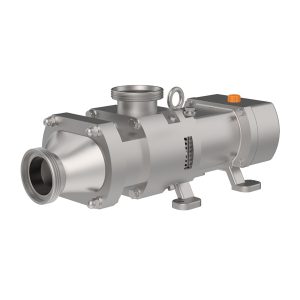This month, our technical sales manager Bruce Greig accomplished a fantastic sale with a well-known Australian personal care and cosmetics manufacturer.
As part of a new project, the personal care company was originally inquiring into a Scanjet bio 10 Rotary jet head for application in tank cleaning. Their previous Scanjet jet head was supplied back in 2020 and they were looking to purchase another one.
Whilst organising this replacement, they mentioned needing a positive displacement pump in the processing of sunscreen.
We gathered all duty flow-rates, pressures and temperatures and got straight to gathering a list of potential options for the customer to look at. The three main options that were selected were the ZP3 from Ampco, a Circumferential Piston Pump (30kw), the CSF PC Pump (22kw), and the OMAC b440, a B series rotary lobe pump (18.5kw). However, the existing infrastructure could only hold up to 18.5kw-22kw, which narrowed down the options. The ZP3 circumferential piston pump was higher in KW, leaving the CSF-PC and OMAC pump the best options among the three. Although, a fourth option emerged: the CSF TS twin-screw pump.

From a customer’s point of view, the twin-screw pump technology is “generally the most expensive option, but it has some advantages: it can pump products close to water velocity, but also at very high levels of up to 1,000,000 centipoise.” Therefore, being the more efficient solution for pumping liquids with varying media viscosities, the twin-screw pump is demonstrably superior to the rotary low pump when it came down to having more flexibility with pumping sunscreen products. Moreover, if the customer had chosen the rotary lobe pump, they would have to acquire an additional pump to clean it. To do so requires considerable pipe work, valves and potentially multiple pumps; the twin screw pump is unencumbered by these issues.
The ZP3 piston pumps consumed more energy than required, the PC pump was physically too large and long, and the rotary pump would work with size and KW, but complications arose with the need for CIP(cleaning in place). Bruce held off from quoting the twin screw pump straight away because he noticed some conflicting calculations regarding the pressure drop that he was sent. We utilised our pressure drop calculator while on-site to double check all the numbers, but it also used to optimise the longest Flow path and Pressure Drop to offer a pump that is truly customised to the client’s needs with regards to duties, production demand, future growth and cost effectiveness in maintenance.
The pressure bar was originally 12 bar, but with the pressure drop calculator Bruce found that in actuality it was 16, allowing us to offer a smaller and more cost-effective pump. Flowtherm resubmitted this to the client and they said that it was great.
For the end-user, the twin screw pump ‘covered all his solutions. “The CSF Twin Screw Pump, with its clean-ability and ability to fit the existing electrical architecture, saved money while addressing and solving the core problem in the chain of production of sunscreen. While not an obvious choice at first, the twin screw pump made one ‘happy’ customer.
